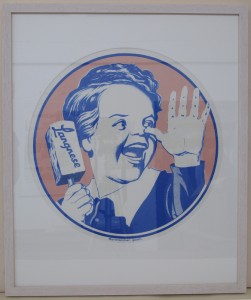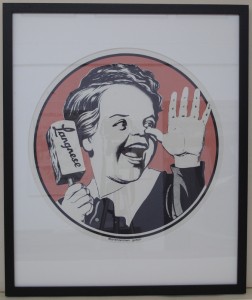aaa

AAA
Das Motiv des Langnesejungen wurde von einem originalen Lithographiestein aus dem Jahr 1935 gedruckt. Es handelt sich dabei um einen von 3 Steinen, die zur Herstellung des mehrfarbigen Plakates notwendig waren. Der Stein wurde 2003 käuflich erworben, restauriert und wieder „druckbar gemacht“. Da das Motiv seitenrichtig aufgebracht wurde, kann man davon ausgehen, dass Blech als Bedruckstoff in einer Offsetandruckpresse verwendet wurde.
The motif of the Langnese boy was printed by an original lithographic stone from 1935. This is one of three stones that were required to produce the multi-coloured poster. The stone was purchased in 2003, restored and made “printable” again. As the motif was applied laterally correct, it can be assumed that tin was used as the printing substrate in an offset proofing press.
AAA
Hintergründe/Background:
Der Kaufmann Karl Rolf Seyferth suchte 1927 im Hamburger Fremdenblatt einen Markennamen für seine bestehende „Deutsch-Chinesische Eisproduktionsgesellschaft“ die sich auch mit der Herstellung von Honig beschäftigte. Zu dieser Zeit gab es eine Biskuit-Fabrik in Hamburg mit hervorragendem Ruf bezüglich Qualität und Engagement. Diese Fabrik gehörte dem Exportkaufmann Viktor Emil Heinrich (V. E. H.) Langnese. 1927 übernahm Seyferth die Firma V. E. H. Langnese, gegründet 1888, für 300 Reichsmark und sicherte sich den Markennamen Langnese.
Seyferth importierte 1935 eine dänische Errungenschaft nach Hamburg: Eis am Stiel. Ein heißer Sommer und ein Preis von 10 Pfennig brachten den Erfolg. Mehr als 1,5 Millionen Eislollis, wie der Volksmund das Langnese-Eis nannte, wurden in der ersten Saison verkauft. Auf dem damaligen Firmenzeichen machte, passend zum Namen, ein Junge mit einem Eis am Stiel eine lange Nase. Die Nationalsozialisten bremsten 1936 das junge Geschäft aus. Karl Seyferth wurde die für die Herstellung von Eiskrem notwendige Milch und Sahne verweigert.The businessman Karl Rolf Seyferth placed an advertisement in the Hamburger Fremdenblatt newspaper in 1927 to look for a brand name for his existing “German-Chinese ice cream manufacturing company”, which was also involved in the production of honey. At that time, there was a sponge cake factory in Hamburg with an outstanding reputation for quality and commitment. This factory belonged to export merchant Viktor Emil Heinrich (V. E. H.) Langnese. In 1927, Seyferth took over the company V. E. H. Langnese, founded in 1888, for 300 Reichsmark and secured the brand name Langnese.
Seyferth introduced a Danish creation to Hamburg in 1935: ice cream on a stick. A hot summer and a price of 10 pfennigs brought success. Over 1.5 million ice lollies, as people called the Langnese ice cream, were sold in the first season. In keeping with the name, a boy with an ice cream on a stick thumbed his nose on the company’s logo at the time. The Nazis thwarted the young company in 1936. Karl Seyferth was refused access to the milk and cream he needed to produce ice cream.
Quelle: Wikipedia
____
_____
 AAAAmit Passepartout, ohne Rahmen
AAAAmit Passepartout, ohne Rahmen
AAAAVersion: blau/rot
AAAATechnik: 2-farbiger Steindruck
AAAAHxB: 60 cm x 50 cm
AAAAPreis: 80,-€
__
__________
AAAAA
__
__
__
 AAAAmit Passepartout, ohne Rahmen
AAAAmit Passepartout, ohne Rahmen
AAAAVersion: schwarz/rot
AAAATechnik: 2-farbiger Steindruck
AAAAHxB: 60 cm x 50 cm
AAAAPreis: 80,-€
AAAA
_____
_____
a
AAAAlle Preise zuzüglich 19% MwSt. (seit 01.01.2014) und Versand. Datenschutzerklärung
AAAAA
aaa